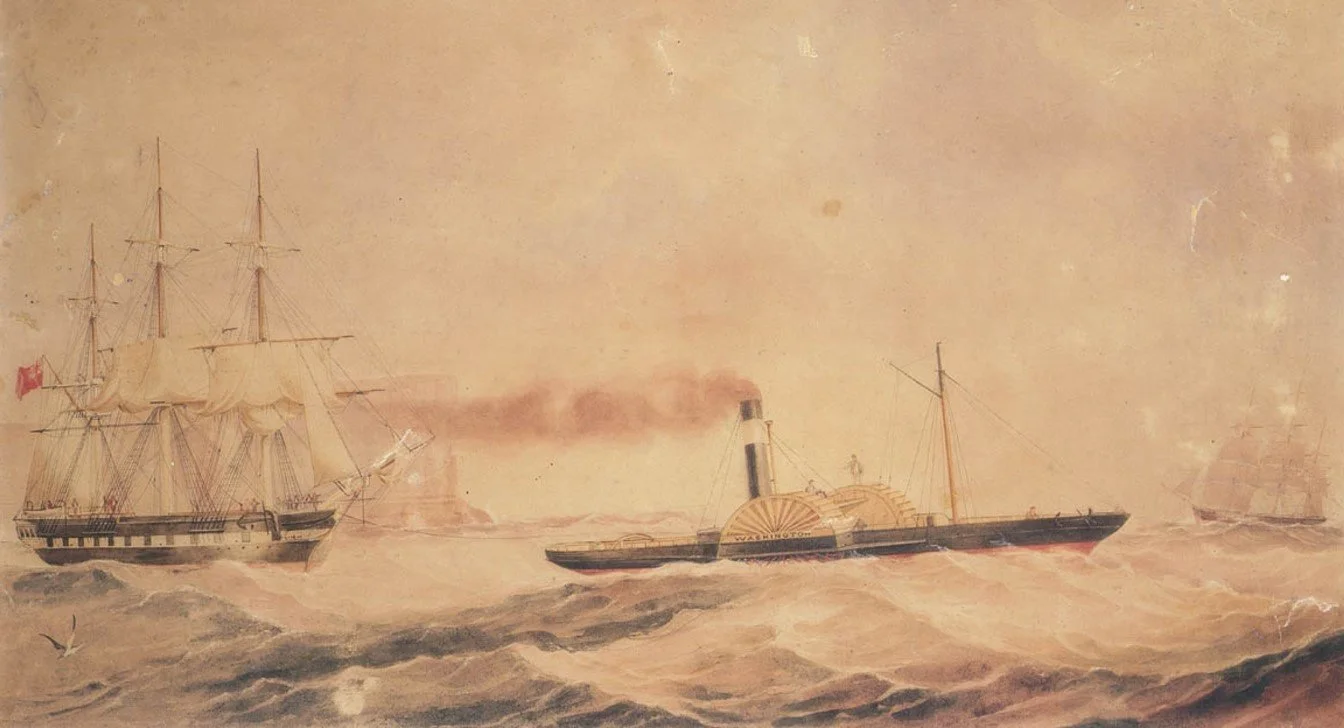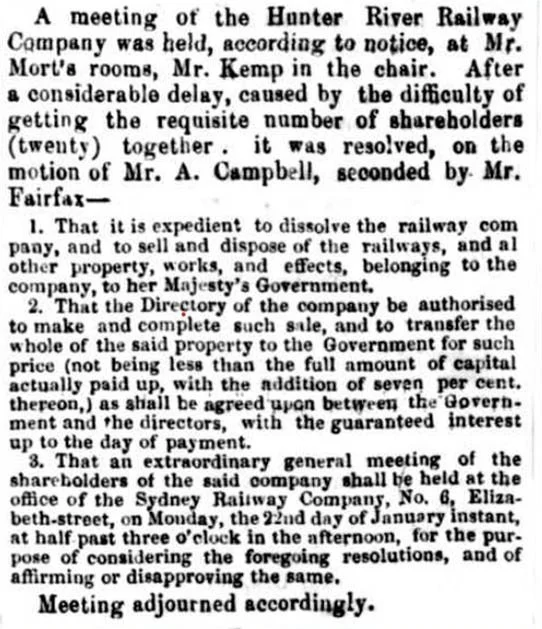Hunter River Railway Company 1853-1855
The 1850s witnessed the beginnings of rail transport in the Hunter. Until then, goods and people moving to and from the district and to and from northern New South Wales travelled by steamship from Morpeth to Sydney. This was expensive and proved increasingly inadequate. A railway, initially between Maitland and Newcastle, offered an alternative. The formation of the Hunter River Railway Company was a first step in this direction.
Creation and incorporation
On 20 April 1853, a meeting of gentlemen was held at the Royal Hotel, Sydney, to propose the establishment of a railway company to initiate the construction of a line between Newcastle and Maitland. Invitations to attend the meeting were sent to prominent businessmen in Sydney and a number of members of the NSW Parliament. Those attending were W.C. Wentworth (Chair), Sir Charles Nicholson (Speaker of the House), W. Bradley, C. Cowper, T.W. Smart, Captain King RN, Dr Douglas, (all parliamentarians) as well as Captain W. Russell, J. Gilchrist, T. Holt, J. B. Darvall, T.S. Mort, J.E. Ebsworth, C. Kemp, S.D. Gordon, David Jones, Dr Mitchell, John Croft, J.F. Josephson and ‘a number of the most respectable commercial men in Sydney’.
The meeting incorporated a company called ‘The Hunter River Railway Company’ with a capital of not less than £100,000, amounting to 20,000 shares at £5 each. Applications for 50,000 shares were subscribed on the day. The Company’s office was to be in Mort's Buildings, Pitt Street, Sydney. The railway was to run between Newcastle and Maitland, with sea communication to Sydney.
Controversy began almost immediately. An opinion piece in the Maitland Mercury of 8 June 1853, queried the way in which the shares had been distributed, denying the citizens of Newcastle and Maitland a say about a railway within their region.
The Company was unconcerned and the Company’s solicitors, Norton, Son and Barker, went ahead with preparing an application for incorporation to be made to the Legislative Council. The application was received and, on the third reading of the Bill on 30 September 1853, the Act of Incorporation was passed.
The first general meeting of shareholders was held on 8 November 1853.
Getting supplies
No time was lost in commencing operations.
Plans were purchased from Mr Lundie, who had surveyed the route about ten years previously. Mr Wallace, engineer-in-chief of the Sydney Railway Company, was appointed as Consultant Engineer. Mr Higham was contracted as surveyor; Mr J. N. Gale appointed resident engineer; and Mr Wright’s tender for building the earthwork and bridges between Newcastle and Hexham was accepted.
At the same time, the first orders and remittances (£17,000) were sent to the Company’s London agents, Messrs P. W. Fowler and Co, for 500 railway labourers and a quantity of rails and plant.
On 31 October 1853 and after a long and difficult 107 day voyage, the ship Ellenborough arrived from Southampton. It carried 399 immigrants, 100 of whom were labourers for the railway. Part of the cargo consisted of items for the Hunter River Railway Company. These included: 10 pick shafts, 7 crab winches, 35 bundles iron, 4639 chairs, 1023 rails, 164 bundles shovels, 3 casks picks, 534 bars iron, 1201 pieces iron, 16 pieces machinery, 80 axle boxes, 3 castings, 14 pairs and 149 barrels wheels and axles, 23 casks, 12 cases.
The ship Ellenborough being towed into port by the steam tug Washington.
Watercolour by Frederick Garling (1806-1873)
Construction and dissolution
The first sod for the railway was turned by the chairman of the Company on 8 November 1854. There was no ceremony apart from three cheers from all those present. Railway construction then began from Newcastle towards Hexham.
The Company, however, soon fell into financial difficulty. In early January 1855, a meeting of shareholders recommended dissolving the Company.
Also in January 1855 the NSW Government published the names of the Commissioners of Railways -Edward Wolstenholme Ward, Captain, Royal Engineers was Chief Commissioner with Thomas Barker and Charles Kemp (chair of the Hunter River Railway Company) as Commissioners. The Commissioners’ posts were created under legislation passed in November 1854 based on the principle of publicly owned-railways in the colony.
On 23 April 1855, The Hunter River Railway Company was sold to the NSW Government. Shareholders eventually recovered their capital and five per cent in debentures. The amount of paid up capital in the Company at the time of its dissolution was £55,000.
The enthusiasm for the railway venture started by the Hunter River Railway Company is evident in a circular published by Messrs Bingle and Sons of Newcastle in March 1855. Reprinted in the Maitland Mercury, it in part declared:
“Every year will add to the length of its line, and as it is contemplated by the Hunter River Railway Company to run the line to the utmost extent of the northern districts, to New England, it will add to the means of our shipping the whole of the pastoral produce at our port.”
Under government ownership the Hunter River Railway became the Great Northern Railway, and the rail line was extended.
Visit East Maitland to Hexham for Part 2 of my account of the building the Great Northern Railway.
References
Henderson, Lawrie ‘Our past: the first moves to establish a rail link from Newcastle to Maitland’, Maitland Mercury, 18 August 2020.
‘Main Northern railway line’, NSW Trains Wiki.
Maitland Mercury and Hunter River General Advertiser, 1853 – 1855.


